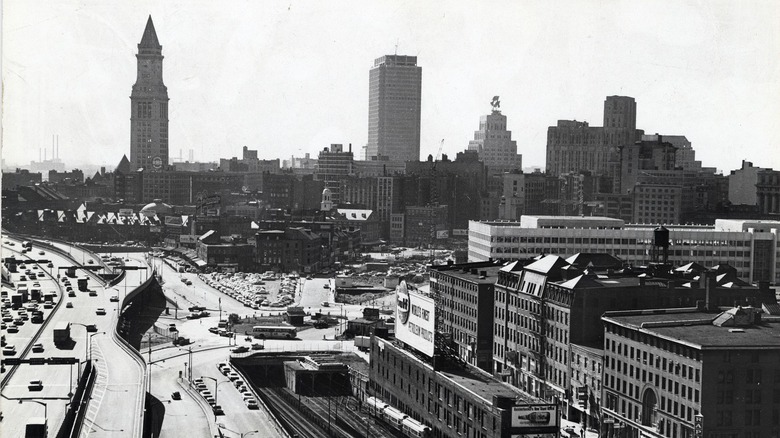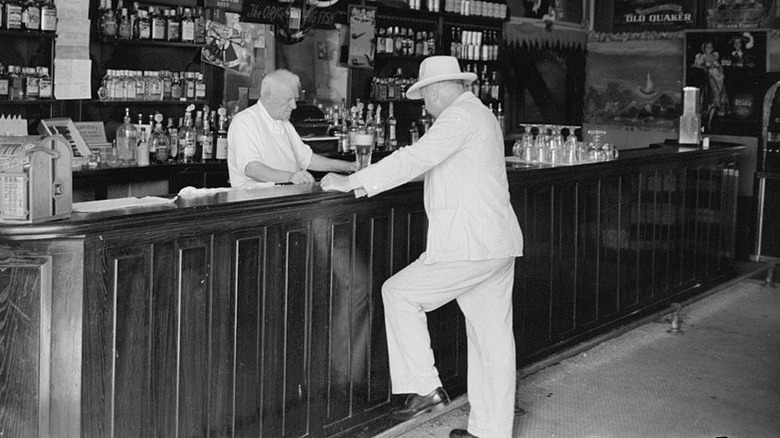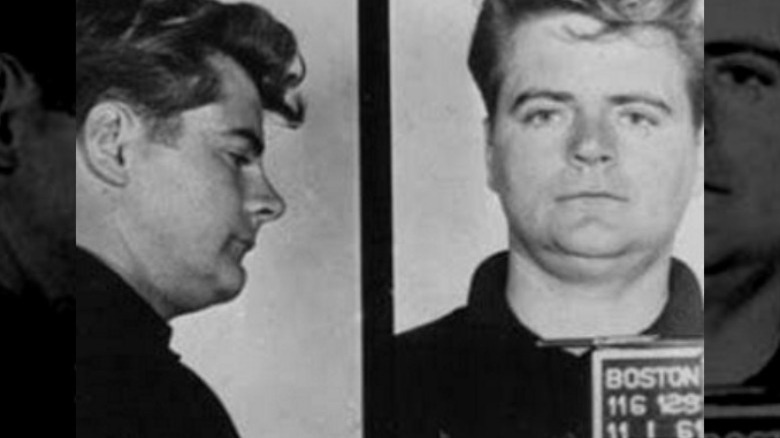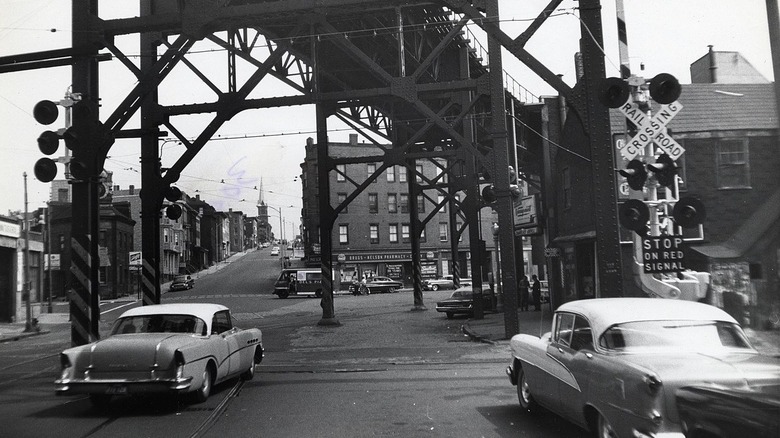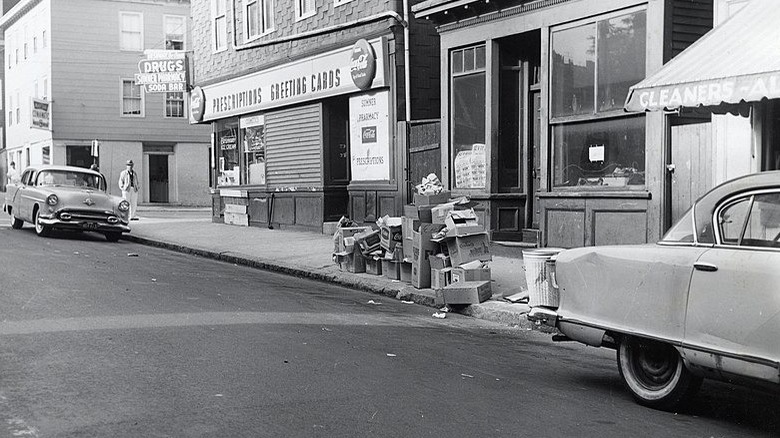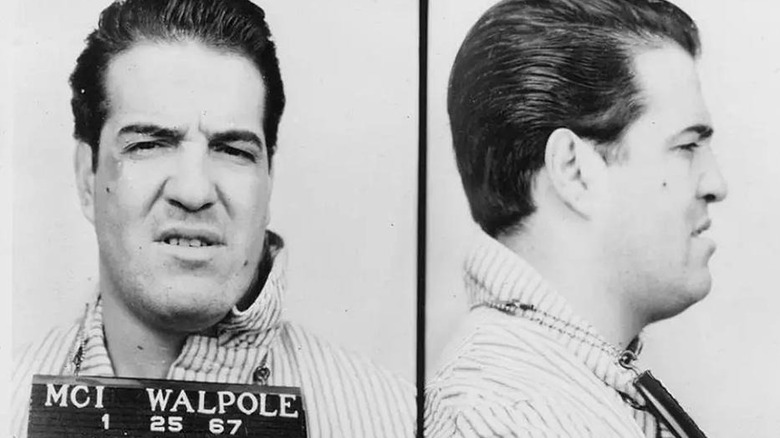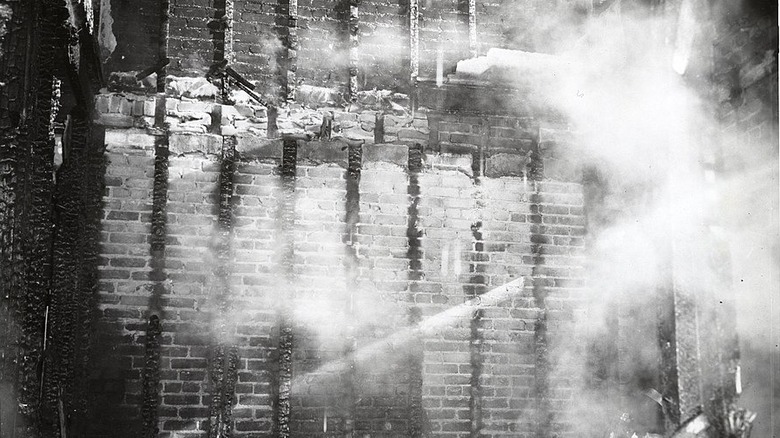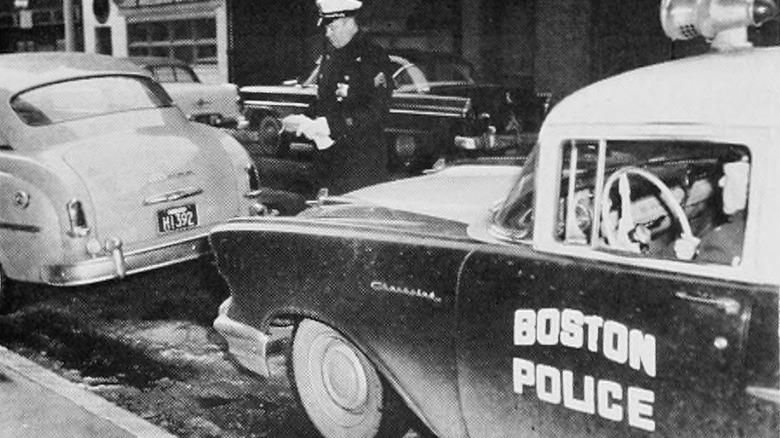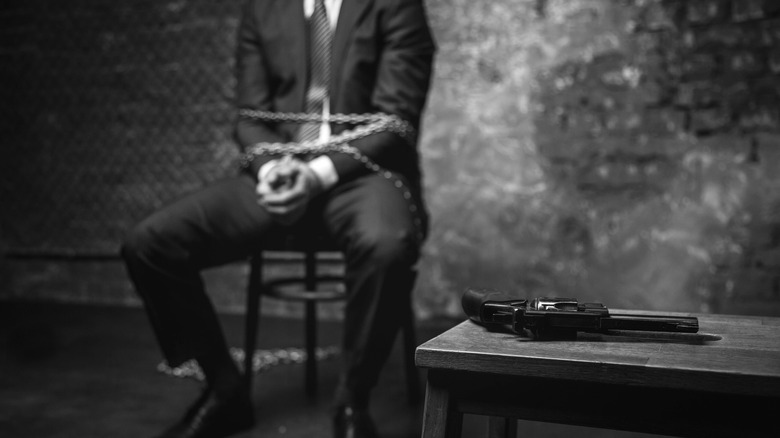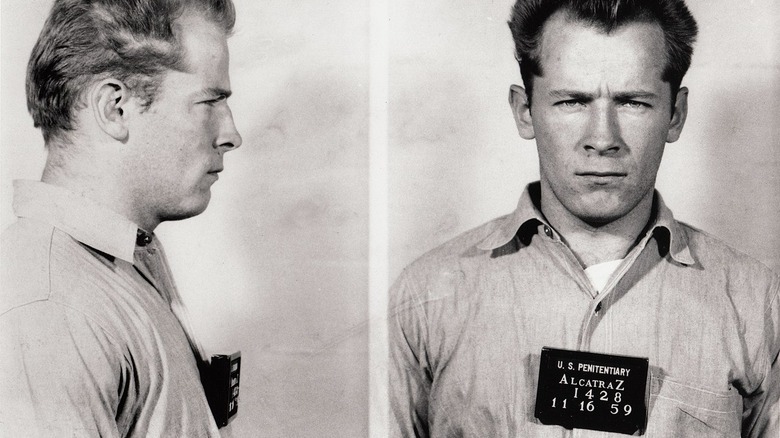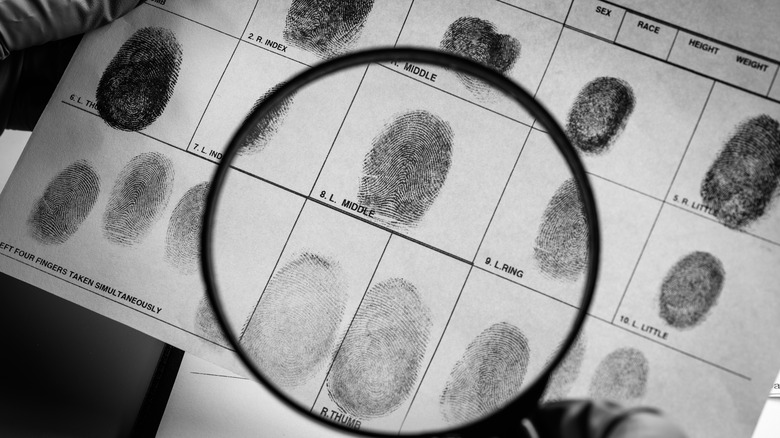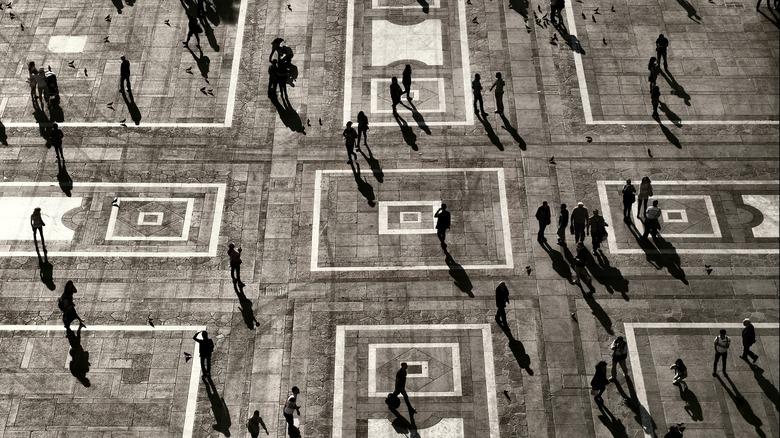Chilling Details About The Boston Irish Gang Wars
Revenge, they say, is its own executioner. To observe this harsh moral play out in a macabre fashion, one only needs to look at the bloodshed that soaked the streets of Boston from 1961 to 1966. The Boston Irish Gang Wars would leave a trail of heartbreak in their wake as the violence intensified, killing scores and severing families forever, per the New England Historical Society. Assassinations, gang shootouts, and car bombs gripped the daily lives of Bostonians. Dread reigned supreme in the city, leaving a grim legacy in Boston's history.
Surprisingly, this carnage did not begin as an effort to conquer territory or settle ethnic conflicts. Instead, a battle was fought between Irish immigrants and their Americanized offspring over pride, honor, and vengeance. As author T.J. English writes in the book ''Paddy Whacked,” Boston in the 1960s was a metropolis of uneasy factions living in an anxious coexistence. Many of those involved in organized crime also masqueraded as everyday citizens. According to National Geographic, many of the working-class Irish-American communities that had grown up in the city's projects had solid links to the underworld, which dealt in bookmaking, gambling, and protection rackets.
The McLaughlins, sometimes known as the Charlestown Mob, and the Winter Hill Gang are the key actors in Boston's Irish Gang Wars, per LIFE. What began as a drunken indiscretion swiftly snowballed as gang leaders and their faithful pawns resorted to severe violence and intimidation to gain the upper hand and survive.
[Featured image courtesy of City of Boston Archives via Wikimedia Commons | Cropped and scaled | CC BY 2.0]
It began over booze
When we consider the first butterfly wing that led to a brutal hurricane that had Boston on edge for several years, it's surprising to observe how it all might have been avoided if cooler heads prevailed. George McLaughlin, a well-connected member of the McLaughlin family, by some accounts, drank too much one Labor Day weekend and got abrasive and handsy with the girlfriend of a Winter Hill gang member. As Beverly Ford's ”The Boston Mob Guide” relays, two Winter Hill gangsters wasted little time beating McLaughlin senseless. Then, fearing they had gone too far, the duo abandoned a barely alive McLaughlin in front of a nearby hospital, according to ''Paddy Whacked.”
Eventually, McLaughlin would recover enough to lick his wounds and learn his lesson. However, his elder brother Bernie McLaughlin couldn't let this transgression pass unpunished. Bernie wanted someone to pay, so he went directly to one of the Winter Hill Gang's most powerful members, James J. "Buddy" McLean, for answers, sealing both men's fates. ”Boston Mob'' by Marc Songini describes McLean as "the man at the top of the Hill." Truck driver by day, mob member at night, McLean was a charismatic pillar of his community, who looked ”like a choir boy but [fought] like the devil,” per ”Paddy Whacked.” After McLean refused to rat out his fellow gang members, an irate Bernie left this encounter with vengeance in his heart.
The first murder had 100 witnesses
Sources diverge on exactly how long it took for the tension to turn into mayhem, but many agree it wasn't long before the brewing maelstrom of gang warfare arrived directly at Buddy McLean's front door. As ''Paddy Whacked'' tells it, on the night before Halloween in 1961, McLean (pictured) was alerted by barking dogs to sinister figures near his home. Outside his window, he spotted two men in his driveway. In keeping with his formidable reputation, McLean leaped into action and fired his Luger pistol three or four times in the direction of his fleeing assailants, per "Boston Mob."
McLean later discovered five sticks of dynamite fastened to his car (via LIFE). If he hadn't spotted it, this homemade bomb could have detonated, killing McLean or his family. McLean recognized at once that the McLaughlin gang had planted the explosives. The battle had begun, yet McLean would draw first blood. The next day, Bernie McLaughlin walked through Charlestown's City Square, oblivious to the dangerous foe who was stalking him. Suddenly, out of the crowd came five rapid pistol shots, and McLaughlin was slain, according to ”Boston Mob.”
While many stories of this incident describe McLean as the gunman, the shocking reality was that there were more than 100 witnesses to this grisly murder, according to "The Boston Mob Guide." Yet, when the cops inevitably came calling for witnesses, nobody saw a thing. Fearful witnesses had donned their blinders, and the eye-for-an-eye executions began.
Sidewalk soldiers were everywhere
As the bedrock of Boston's underworld fractured, many criminal groups were pressured to pick a side and join the purge. Some Irish clans had mutually beneficial partnerships with many players in the Italian Mafia, who ran a variety of legitimate and illicit enterprises in Somerville and Charlestown (pictured), reports National Geographic. Luckily for Buddy McLean, he was, according to "Boston Mob," well-liked, and he quickly cajoled his Italian Mafia connections to help him.
The question of how extensively Italian Mafia hitmen played a part in the Boston Irish Gang Wars of the 1960s remains speculative. While some accounts suggest that some of the Irish gangs hired the Italian Mafia to carry out hits, others claim they played a more passive role, simply providing the Irish gangs with weapons and vehicles, or stood back to watch as the Irish gangs killed each other, per "Boston Mob" and Vincent Teresa and Thomas C. Renner's "My Life in the Mafia."
Still, certain criminals with deep connections to the Boston's Italian Mafia admitted to taking up arms. Joseph "The Animal" Barboza was an infamous Boston contract killer who aided the Winter Hill Gang, and many perished at the point of his gun, according to ''The Boston Mob Guide.” An ex-Mafia boss nicknamed "Cadillac Frank" Salemme also testified about his involvement in the murder of eight people by the Irish mobs in the 1960s, per The New York Times. "The Hugheses, the McLaughlins, they were all eliminated, and I was a participant in just about all of them, planned them and did them," he later acknowledged.
[Featured image courtesy of City of Boston Archives via Wikimedia Commons | Cropped and scaled | CC BY 2.0]
Ambushes around every corner
With many loaded guns and faces in the crosshairs, gangsters and ordinary Bostonians walked the tightrope between life and death every day. It seemed that murderers lurked around every corner, ready to pounce. Furthermore, there was no escape from the consequences of gossip and whispers reaching the wrong ears. No one knew whether or not former allies had switched sides, and many of the combatants had to carefully tread such minefields.
Nightclubs, homes, bus stops, and even waiting at the traffic lights could prove deadly, per "My Life in the Mafia." Grace Petricone, the lady who George McLaughlin first dishonored, narrowly survived a car bomb intended for Howie Winter, one of Buddy McLean's top men, as reported by The Boston Globe. As tit-for-tat homicides escalated throughout Boston, the lengths to which some assassins went to get their mark grew ever more drastic. "Paddy Whacked" tells the remarkable tale of how "Cadillac Frank" Salemme and Joseph Barboza disguised themselves as rabbis and attempted to assassinate Edward "Punchy" McLaughlin, brother of George and Bernie, in a hospital parking lot.
Even daily routines could prove fatal. As "Boston Mob" reports, Jimmy "The Bear" Flemmi, a Winter Hill Gang mobster, was shot multiple times by two gunmen. They found him because he ate supper at home every night at the same time. Similarly, Punchy McLaughlin, who had survived several ambushes by 1965, was finally gunned down while boarding the same bus he had traveled on every day for a week on his way to his brother George's trial, via "Boston Mob."
[Featured image courtesy of City of Boston Archives via Wikimedia Commons | Cropped and scaled | CC BY 2.0]
Tortures and dismemberments
Chilling levels of cruelty were reserved for high-profile killings, sending a message to gang rivals or scaring any witnesses. In addition, torture and other forms of extreme violence were often utilized in the early 1960s to coerce informants and instill fear among competing criminal organizations. Unfortunate victims' remains were occasionally discovered tied up and with signs of torture, according to "Boston Mob." Despite the criminal code of silence, many of these details are known today thanks to interviews with people who witnessed the atrocities firsthand or knew about them via word of mouth.
As Joseph ”The Animal” Barboza (pictured) would later testify to the FBI, ”People were found in backs of trunks with their heads sawed off. People were found in suitcases, dissected. Guys were found floating in the river. There was a lot of hits in Boston and all different types of hits that put a lot of fear into these people."
Howie Carr's book "The Brothers Bulger" supports this gruesome assertion when it details how Jimmy "The Bear" Flemmi, a vicious Winter Hill gun for hire, decapitated a victim in 1964 and dumped the body right in one of Boston's housing projects. Captured gang members didn't fare much better. One dark and grisly tale is the legend of two Charlestown gangsters who thought they were getting lucky, only to be duped into a trap and tortured by Buddy McLean for information, as told in "Paddy Whacked." Warning: The results weren't pretty.
Innocent people suffered
Throughout the Boston Irish Gang Wars of the '60s, an oppressive smog of anxiety hovered over the city and clouded the lives of many Bostonians. To add to the nightmarish mood, The Boston Strangler was also in the middle of a sickening murder spree between 1962 and 1964. By the time Albert DeSalvo was behind bars, 13 women would be dead, per History.
When it came to mob shootouts, innocent bystanders were frequently caught in the crossfire and exposed to arbitrary acts of violence. One curious time capsule is a feature piece by LIFE Magazine in 1967, which describes the mental toll that the violence had on the psyches of everyday folks. It alludes to a mass reluctance to leave their homes at night and a fear of talking to strangers lest they join the "corpses sprawled on sidewalks."
There was also intense pressure to avoid speaking with the police, and mob members had little desire to leave witnesses to their massacres. According to Reuters, one of the darkest days of the killings was November 16, 1965, when authorities discovered the bodies of three victims at a café. One of the victims, tragically, was blameless. John B. O'Neill, a 26-year-old father and husband, was shot dead by suspect Joseph Barboza as he attempted to flee. In his revealing memoir "My Life in the Mafia," former Mafioso Vincent Teresa stresses the senselessness of this tragedy. Teresa claims O'Neill was murdered because Barboza did not want witnesses.
[Featured image by City of Boston Archives via Wikimedia Commons | Cropped and scaled | CC BY 2.0 ]
Rampant police corruption
So, where were the cops amid the chaos? While a lack of witnesses was a thorn in the side of the Boston Police Department, it was far from the only reason they failed to stem the bloodshed. Police efforts to avert violence were regularly thwarted by gang members' extensive connections within the federal government. H. Paul Rico, a disgraced FBI agent, is a cliché example of the crooked cop, who frequently pitted gangsters against one another for his own benefit.
"Paddy Whacked" details a heinous case in which Rico knew about the imminent murder of Edward "Teddy" Deegan but failed to act. Instead, Rico remained mute while the police scrambled for suspects and falsely convicted innocent men. To avoid having Uncle Sam's gavel fall on their heads, several mobsters even resorted to snitching as government informants. Stephen Flemmi was one such high-ranking member of the Winter Hill Gang who exploited his deep ties to Rico, according to Howie Carr's book "Rifleman." Flemmi regularly protected his allies in return for information that led to the arrest of his adversaries, per "Boston Mob Guide."
The memoir "Brutal" from Kevin Weeks, a ruthless enforcer of the Bulger gang, claims that another FBI agent set Edward "Punchy" McLaughlin up to be murdered, even providing the Winter Hill Gang with the location of the bus stop McLaughlin used every day. Decades after the dust cleared from this mob battle, the public would learn of the insidious roots between police corruption and organized crime (per The New York Times), which severely damaged the reputation of Boston's blue.
The violence continued for years
By 1965, many of the initial instigators in the Boston Irish Gang Wars were eliminated. Bernie and Edward McLaughlin were dead, and George McLaughlin was behind bars. Buddy McLean, who had outwitted the Reaper multiple times, eventually met his demise at the barrel of a gun outside a bar in 1965, per '"Boston Mob Guide." Even the murders of two of the last known McLaughlin hitmen, Stevie and Connie Hughes, did not break the deadly cycle of violence. Such killings did little to quell the rivalries between Boston's Irish-American factions, and tensions remained high for the rest of the decade.
After the McLaughlin clan disintegrated, various other clan chiefs arose to take its place. As alliances formed and dissolved, a powder keg lay beneath the projects of South Boston, ready to explode at any time. Violence and casualties persisted as warring groups fought over the city's criminal underbelly. One such saga is the bitter feud between the Mullin and Killeen gangs in the latter half of the decade, via "Paddy Whacked."
In "Brutal," Kevin Weeks recounts how this gang war erupted when a barroom brawl turned sour after one of the Killeen's clan bit off part of the nose of a Mullin Gang member. The ensuing tit-for-tat turf war would end with the death of the Killeen gang's patriarch, Donald Killeen, paving the way for a notorious Boston mobster, newly freed from prison, to establish himself as the new power broker.
The Boston Irish Gang Wars led to decades of crime
Gang violence spilled into the subsequent decades. By 1972, the Winter Hill Gang had virtually eliminated their competition and wielded considerable sway in the city. After Donald Killeen, patriarch of the Killeen family, was murdered in his home in 1972 (per "Paddy Whacked"), the Winter Hill Gang and the Mullins seemed poised to wipe out the remnants of the Killeen clan, as "The Boston Mob Guide" reports.
However, in the early 1970s, Whitey Bulger (pictured), one of America's most notorious career criminals, stepped into the power vacuum that existed in South Boston and prevailed. When the Winter Hill-McLaughlin conflict broke out, Bulger was doing time on the forsaken prison island of Alcatraz, then in Lewisburg, Pennsylvania, before being paroled in 1965, according to "Paddy Whacked." But, before long, he had reverted to old habits and became a crucial player for the Killeens. After Donald Killeen's murder, Bulger capitalized on a seemingly hopeless position.
Remarkably, the magnetic Bulger brought these warring factions to the table and mediated a truce, allowing the other gang leaders to continue their rackets undisturbed. In exchange for this union, Bulger gained control over South Boston, per ”Paddy Whacked.” Although Bulger had prevented opposing gangs from killing each other, Boston's gang-related problems persisted. Naturally, these activities only survived with some help from the authorities, most notably disgraced FBI agent John Connolly. Throughout Bulger's tenure, corruption flourished and festered. Reuters confirms revelations regarding the full scale of the corruption that benefited Bulger and his associates in the 1970s and beyond.
Many killers evaded real justice
Many of those who prolonged the agony of ordinary Bostonians and tore families apart eluded prosecution for decades or earned "get out of jail free" cards in the aftermath of the violence. Whitey Bulger and his close partner Stephen Flemmi were shielded by their "handler," FBI agent John Connolly, who hindered multiple arrest efforts. As The Boston Globe maintained, Bulger saved his own skin for decades in exchange for intel on the Italian mob.
Remarkably, the trigger-happy Joseph ”The Animal” Barboza avoided real jail time. According to "Boston Mob," Barboza became an informant against numerous high-ranking Italian Mafia members. "Cadillac Frank" Salemme, who confessed to murdering eight people during the '60s, went to jail in 1973 for a botched car bomb. He became head of the New England Mafia upon release in 1988. Salemme even reconnected with Bulger before being charged with racketeering in 1995. As The New York Times reports, Salemme turned on Bulger and his friends by offering intel in exchange for an early release in 2003.
Barboza, like Salemme, would be relocated and placed in the Witness Protection Program. Yet, Barboza would face a revenge served cold in 1976, when he was finally tracked down in San Francisco and shot, via "Boston Mob." Ralph Ranalli's "Deadly Alliance" adds that Bulger gang member Kevin Weeks also negotiated a plea deal with investigators in return for information that helped him evade a life sentence. In "Brutal," Weeks reveals how he reduced his prison sentence to just 72 months by telling FBI investigators where several victims were buried.
The true death toll remains unknown
Despite all the pain and devastation documented during the Boston Irish Gang Wars of the 1960s, one sobering question lingers: What was the exact number of lives lost during the struggles? Due to the covert nature of the conflict and the code of silence that bound offenders and bystanders together in terror, an exact death toll still eludes researchers. Contradictions exists between numerous sources, so many estimates must be considered with a grain of salt.
The LIFE Magazine exposé published in 1967, two years after the pinnacle of the Winter Hill-McLaughlin bloodshed, lists 43 victims. However, newer sources, such as Reuters and "Paddy Whacked," place the death toll at 60. Yet, for some, this revised statistic is suspect. Even though there is a chance that the media or police misidentified some of the recorded deaths as Gang War casualties, "Paddy Whacked" admits that other killings may have gone unnoticed. Some primary witnesses, who related their experiences in their memoirs, have cast doubt on even the higher estimates.
In "My Life in the Mafia," Vincent Teresa advances the chilling idea that many bodies were just never located and that the actual number is higher, further complicated by many killings being the settlement of old disputes. Even more disturbing is Winter Hill Gang member Kevin Weeks; assertion in "Brutal" that 82 people died in the carnage. The precise death toll from the 1960s Boston Irish Gang Wars remains shrouded in mystery, and we may never know the full scope of the suffering.
